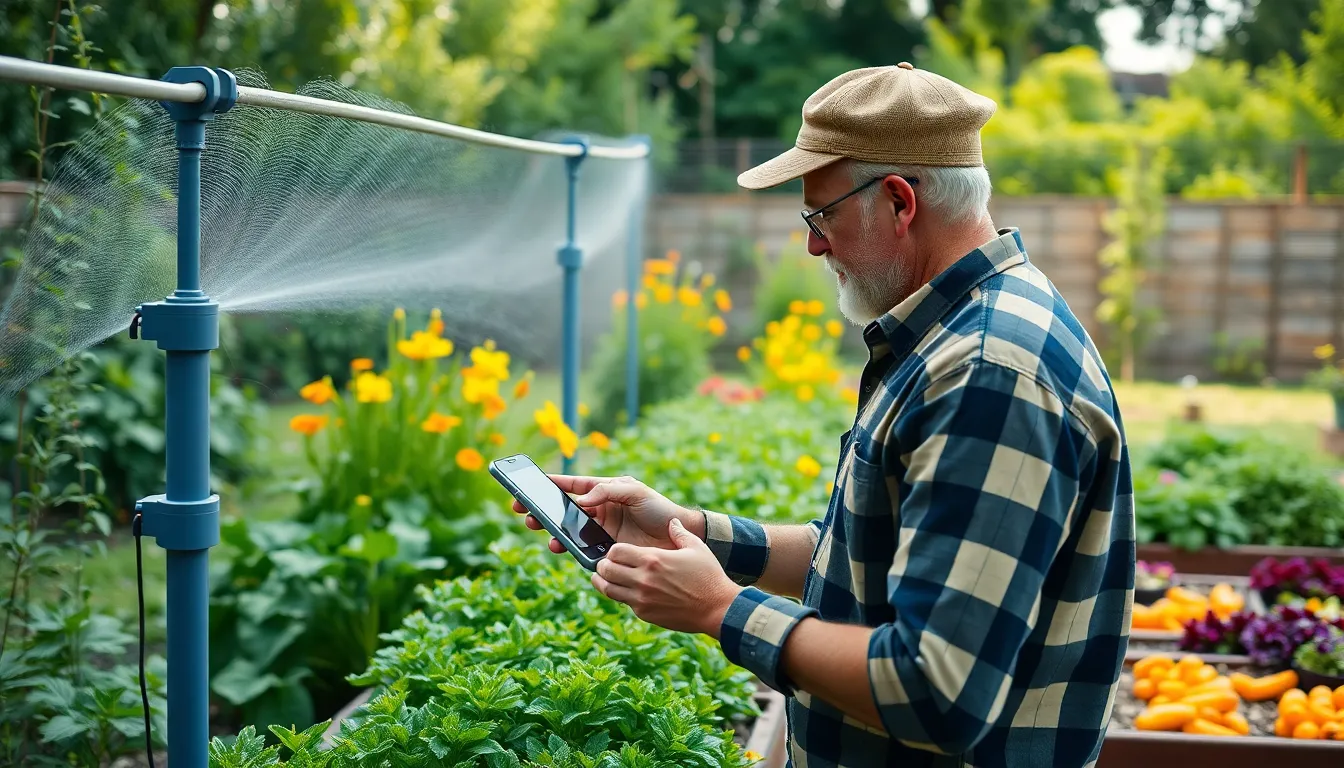In a world where even your fridge can remind you to buy milk, why should your garden be left in the Stone Age? Smart gardening technology is here to transform your green thumb into a high-tech powerhouse. Imagine a garden that waters itself while you kick back with a cold drink, or a plant that sends you a text when it’s thirsty. Yes, it sounds like something out of a sci-fi movie, but it’s very much a reality.
Table of Contents
ToggleOverview of Smart Gardening Technology
Smart gardening technology revolutionizes traditional gardening by integrating advanced tools and systems. Sensors monitor soil moisture levels, ensuring optimal irrigation. These systems connect to smartphones, allowing gardeners to receive real-time updates on plant health.
Automated irrigation systems manage watering schedules based on weather forecasts. This approach conserves water by only providing moisture when necessary. Smart gardening devices also include light sensors, which adjust artificial lighting for indoor plants, enhancing growth.
Drones assist in surveying larger gardens or agricultural fields. They provide essential data regarding plant health and growth patterns. Additionally, AI-based applications analyze this data, offering personalized recommendations for improving plant care.
Many products incorporate machine learning to predict plant needs. These innovations help gardeners make informed decisions about watering and fertilizing. Smart gardening technology promotes efficiency and sustainability in maintaining gardens.
Research shows that smart gardening can increase yields by up to 30%. By employing such technology, gardeners effectively maximize resources and improve productivity. It highlights the shift towards smarter, more environmentally friendly practices in gardening.
Connected devices foster community through shared gardening experiences. Platforms that enable users to exchange tips and data create a supportive environment. Together, these advancements enhance the overall gardening experience, making it accessible to enthusiasts and novices alike.
Benefits of Smart Gardening Technology

Smart gardening technology brings significant advantages to modern gardening. These benefits enhance efficiency and improve plant health.
Increased Efficiency
Automation plays a crucial role in smart gardening, enabling precise watering and nutrient delivery. Smart irrigation systems adjust based on real-time data, ensuring plants receive the right amount of water without waste. Sensor technology monitors environmental conditions, allowing adjustments to be made almost instantaneously. These innovations help gardeners reduce labor hours, as tasks like watering and fertilizing can run automatically. Users report up to a 30% increase in crop yields due to these efficient practices. Efficient systems mean less water is used, promoting sustainable gardening, especially in drought-prone areas.
Enhanced Plant Health
Smart gardening technology greatly benefits plant health through constant monitoring and customized care. Sensors track soil moisture, pH levels, and nutrient content, ensuring conditions remain optimal. Drones equipped with imaging technology provide real-time assessments of plant health, detecting issues before they escalate. AI-based applications analyze gathered data, offering tailored recommendations for care, including pest control and fertilization. By responding promptly to plant needs, gardeners can foster stronger, healthier plants. Overall, these advancements lead to vigorous growth, improved resilience, and better harvests.
Popular Smart Gardening Devices
Smart gardening devices enhance the efficiency and convenience of modern gardening practices. Various products cater to different gardening needs, ensuring plants thrive with minimal effort.
Smart Watering Systems
Smart watering systems automate irrigation to prevent over- or under-watering. These devices utilize soil moisture sensors to determine when plants require water. Timed watering schedules can adjust based on real-time weather data, conserving water resources. Users appreciate the ability to control watering remotely through smartphone apps, making gardening easier, especially for busy individuals. Some systems even allow integration with smart home devices, providing seamless automation. Research shows that these systems can reduce water usage by up to 50%, promoting sustainability in gardening efforts.
Automated Plant Monitor Sensors
Automated plant monitor sensors provide crucial insights into plant health. These devices track factors like soil moisture, temperature, and nutrient levels. Alerts notify users when conditions fall outside optimal ranges, ensuring timely interventions. Many sensors connect to smartphones, presenting data through user-friendly apps. Individuals can receive customized care recommendations based on real-time information, enhancing plant growth. As a result, regular monitoring fosters healthier plants and increases overall yield potential. Using these sensors allows gardeners to make informed decisions, significantly improving care for various plant types.
Future Trends in Smart Gardening
Emerging technologies shape the future of smart gardening. With the rise of artificial intelligence, gardeners can expect more personalized care recommendations based on real-time data collected from sensors and drones. Innovations in machine learning allow these systems to predict plant needs more accurately, adapting to changing conditions and improving yield potential.
Increased use of vertical gardens will expand the popularity of smart gardening. These gardens, often installed in limited spaces, incorporate advanced irrigation and light systems that maximize growth while saving water. Data shows vertical gardens can reduce water consumption by up to 30%, making them an attractive option for urban environments.
Integration of smart gardening with the Internet of Things (IoT) enhances connectivity among devices. Users will control an entire gardening system through a single interface, allowing for seamless management of watering, lighting, and nutrient delivery. This convenience leads to more efficient gardening practices and better resource management.
Robotics play a crucial role in the future of gardening. Automated tools, such as robotic planters and weeders, will take on labor-intensive tasks, freeing up time for gardeners to focus on other activities. Research indicates that incorporating robotics can decrease the labor needed in gardening by up to 40%.
Sustainability remains a central theme in smart gardening trends. Eco-friendly systems, such as composting sensors and solar-powered devices, will become more prevalent. These innovations not only improve gardening efficiency but also contribute positively to the environment by promoting a more sustainable approach to food production.
Lastly, advancements in community gardening platforms allow users to share experiences and knowledge. These collaborative efforts strengthen community bonds among gardeners, fostering a culture of learning and support. As social interaction in gardening increases, both seasoned and novice gardeners reap the benefits of shared expertise and resources.
Potential Challenges and Considerations
Adopting smart gardening technology introduces several challenges for users. Initial costs arise from purchasing devices and installing systems, which may deter some gardeners. Maintenance of these advanced tools requires time and a basic understanding of technology. Users unfamiliar with smart devices can face difficulties during setup and daily use.
Connectivity issues present another potential hurdle. Smart gardening systems rely on a stable internet connection, and disruptions can hinder their functionality. Without connectivity, automated features might fail, leaving plants unattended and vulnerable.
Privacy concerns also exist. Data collection is essential for smart gardening, but users may worry about how their information is utilized. Responsible companies prioritize user privacy, yet skepticism persists among potential users.
Compatibility can affect system integration. Many devices operate on different platforms, complicating seamless interaction between tools. Ensuring compatibility among devices requires research and careful selection.
Environmental factors influence sensor performance. Extreme weather conditions can impact soil moisture sensors and other monitoring tools. Proper placement and calibration are necessary to maintain accuracy.
Limited knowledge about this technology can impede broad acceptance. Educating users about the benefits and operation of smart gardening tools fosters confidence. Resources and community support play crucial roles in promoting understanding.
Lastly, reliance on technology may lessen traditional gardening skills. Gardener reliance on automated systems can diminish hands-on gardening experience. Balancing technology use with fundamental gardening practices strengthens overall skills and knowledge.
Smart gardening technology is transforming how individuals approach gardening. By integrating advanced tools and systems, it not only enhances plant health but also promotes sustainability. With features like automated irrigation and real-time monitoring, gardeners can optimize their practices while conserving resources.
As technology continues to evolve, the future holds even more promise for innovative solutions that cater to diverse gardening needs. Embracing these advancements can lead to increased yields and a more enjoyable gardening experience. Balancing technology with traditional practices will ensure that gardeners remain connected to their craft while reaping the benefits of modern innovation.



